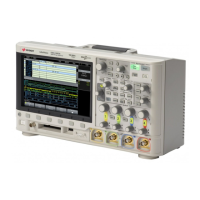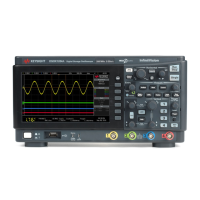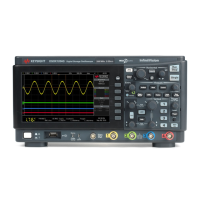Do you have a question about the Keysight DSOX3034T and is the answer not in the manual?
| Bandwidth | 350 MHz |
|---|---|
| Channels | 4 |
| Form Factor | Benchtop |
| Waveform Update Rate | up to 1, 000, 000 wfms/s |
| Vertical Resolution | 8 bits |
| FFT | Yes |
| Input Coupling | AC, DC, GND |
| Timebase Range | 5 ns/div to 50 s/div |
| Connectivity | USB, LAN |
| Maximum Input Voltage | 300 Vrms |
| Trigger Types | Edge, Pulse |
| Interface | USB, LAN |
| Operating Temperature | 0 °C to 50 °C |
| Sample Rate | 5 GSa/s (half channel), 2.5 GSa/s (all channels) |
| Memory Depth | 4 Mpts (half channel), 2 Mpts (all channels) |
Steps for connecting the power cord and turning on the oscilloscope, including power and ventilation requirements.
Instructions for connecting oscilloscope probes to the analog channel BNC connectors and the test point.
How to automatically configure the oscilloscope to best display input signals using the Autoscale function.
Steps to compensate passive probes to match oscilloscope channel input characteristics for accurate measurements.
Using the horizontal scale knob to change the time per division setting for waveform display.
Adjusting the horizontal position (delay) knob to move the trigger point and view pre- or post-trigger data.
Using the vertical scale knob to set the volts/division for a channel.
Using the vertical position knob to move the waveform up or down on the display.
Saving analog channel or math waveforms to one of two reference locations in the oscilloscope.
Steps for connecting digital probes to the device under test and the oscilloscope.
Overview of available hardware-accelerated serial decode options and their licenses.
Adjusting the intensity of displayed waveforms to enhance visibility of signal details and noise.
Configuring waveform persistence (Off, Infinite, Variable) to control how previous acquisitions are displayed.
Adjusting the trigger level for analog and digital channels to set the voltage or threshold for triggering.
Setting up an edge trigger based on slope and voltage level, selecting source and slope.
Triggering on a positive or negative pulse of a specified width or timeout value.
Identifying trigger conditions based on a specified pattern of logic levels and edges across channels.
Triggering on specific lines, fields, or sync pulses of standard analog video signals.
Enabling and setting up triggers for various serial bus protocols like CAN, LIN, SPI, etc.
Choosing between Auto (forces triggers) and Normal (waits for trigger) modes for acquisition.
Using the Run/Stop and Single keys to start, stop, and capture single-shot events.
Choosing acquisition modes like Normal, Peak Detect, Averaging, and High Resolution.
Dividing memory into segments to capture multiple infrequent trigger events efficiently.
Using horizontal (X) and vertical (Y) cursors to measure voltage, time, phase, and ratio on waveforms.
Steps to access the Measurement Menu and add automatic measurements to waveforms.
Understanding and using voltage measurements like Peak-Peak, Maximum, Minimum, Amplitude, Top, and Base.
Using time measurements like Period, Frequency, Pulse Width, Duty Cycle, Rise Time, Fall Time, and Delay.
Creating a mask by configuring the oscilloscope to display a golden waveform and enabling mask testing.
Using the Digital Voltmeter (DVM) feature for 3-digit voltage measurements on analog channels.
Using the integrated hardware frequency counter to measure frequency, period, or edge events.
Configuring and running the Frequency Response Analysis (FRA) feature.
Accessing the Waveform Generator Menu and selecting waveform types and parameters.
Saving oscilloscope setups, screen images, and waveform data to internal memory or USB.
Configuring remote access interfaces like USB device port and LAN.
Establishing a LAN connection for network access, printers, or web interface control.
Connecting to CAN signals and specifying source, threshold, baud rate, and sample point.
Setting up triggers for CAN version 2.0A, 2.0B, and CAN FD signals based on various conditions like frame ID, errors, etc.
Setting up CAN serial decode to decode and display CAN/CAN FD frame data.
Connecting to LIN signals and specifying source, threshold, baud rate, sample point, and sync break.
Setting up LIN triggers based on sync break, frame ID, data, parity, or checksum errors.
Setting up LIN serial decode to decode and display LIN frame data.
Connecting to CXPI signals and specifying source, threshold, baud rate, and tolerance.
Setting up CXPI triggers based on frame types, errors, or events.
Setting up CXPI serial decode to decode and display CXPI frame data.
Connecting to FlexRay signals and specifying source, threshold, baud rate, and bus type.
Setting up FlexRay triggers based on frames, errors, or events.
Setting up FlexRay serial decode to decode and display FlexRay frame data.
Connecting to I2C signals and specifying source, threshold voltage levels.
Setting up I2C triggers for conditions like start/stop, restart, missing ACK, or EEPROM data read.
Setting up I2C serial decode to decode and display I2C data.
Connecting to SPI signals and specifying clock, MOSI, MISO, and framing signals.
Setting up SPI triggers based on data patterns at the start of a frame.
Setting up SPI serial decode to decode and display SPI data.
Connecting to I2S signals and specifying clock, word select, serial data lines, and threshold voltage.
Setting up I2S triggers based on data values, qualifiers, or errors.
Setting up I2S serial decode to decode and display I2S data.
Connecting to Manchester signals and specifying signal, bus configuration, and other settings.
Setting up Manchester triggers based on start of frame, value, or Manchester encoding errors.
Setting up Manchester serial decode to decode and display Manchester encoded data.
Connecting to NRZ signals and specifying signal, bus configuration, and other settings.
Setting up NRZ triggers based on start of frame or data values.
Setting up NRZ serial decode to decode and display NRZ encoded data.
Connecting to MIL-STD-1553 signals and specifying source, high/low trigger thresholds.
Setting up MIL-STD-1553 triggers based on data word start/stop, command/status, or remote terminal address.
Setting up MIL-STD-1553 serial decode to decode and display MIL-STD-1553 data.
Setting up ARINC 429 triggers based on word start/stop, label, parity error, or gap error.
Setting up SENT triggers based on fast/slow channel messages, tolerance violations, or CRC errors.
Setting up UART/RS232 triggers based on Rx/Tx start/stop bits, data values, or parity errors.











